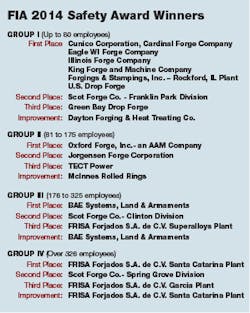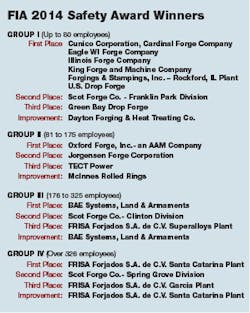It’s difficult to imagine a North American forging operation that does not make a high priority of plant safety standards: keeping operations at or above optimal levels of performance is the baseline for productivity. And yet, the benefits of achieving and maintaining a good plant-safety record can be difficult to quantify: such plants are not paid more for their parts. Generally, the benefits they gain are indirect ones, like lower maintenance and repair costs, insurance cost savings, and greater worker loyalty.
One reward is the recognition that comes with a high score in the FIA’s Annual Safety Awards program. Each year the Forging Industry Assn. surveys member companies to document safety performances at individual plants, tracking OSHA reportable Incidence Rates and Frequency Rates at different plant sites to identify the leading plant-safety performers in the industry. The annual Safety Awards are presented to forging companies in four groups, according to the average annual employment at each location.
FIA gathers information on plant safety records via questionnaires delivered annually to all its producer members. Each plant provides data recorded on OSHA Form No. 300, “Summary of Occupational Injuries/ Illnesses for Calendar Year” for U.S. companies, and from Worker’s Compensation Reports for Canadian companies on the questionnaires.
FIA presents first-, second-, and third-place Safety Award plaques to plants that have the lowest Recordable Cases Incidence Rate, provided that the DART Incidence Rate falls below the group average. In the event that Recordable Incidence Rates are equal, FIA assigns the award to the plant with the lower DART Incidence Rate.
Awards for improvement are presented too, to plants that demonstrated the greatest decrease in the DART Incidence Rate. This is determined by percentage of improvement by DART Incidence Rate compared with the average of the preceding three years.
A certificate of recognition is awarded to each company that does not earn a first-, second-, or third-place rank, and where the Recordable Incidence Rate falls below the group average — provided that the DART Incidence Rate also falls below the group average.
The 2014 FIA Safety Award winners are not the victors in a competition; they are honorees recognized for having overcome the obstacles to failure and liability that undermine peak efficiency. We conducted inquiries with the safety-program principals at each of the operations recognized for 2014 Awards, to determine what made their efforts successful. The following notes make clear what succeeds as a safety strategy, how, and why.
In one sense, the Safety Award winners have bested themselves: each one faces the unique challenges of establishing an estimable safety record within the specific challenges of their own plant. That’s particularly clear for the Group I honorees, where narrow range of activities and low number of employees underscore the singularity of their challenges.
One of the Group I honorees, King Forge & Machine, is a mechanical, closed-die operation forging nickel-based alloys for high-quality valves and fittings, supplied entirely to its parent company, SSP Corp. A representative there said the challenges for its safety program are standardizing adherence to established policies throughout the plant, especially in support areas. Its successful approach involves a) education though monthly safety meetings; and b) MDI (Management for Daily Improvement) efforts (weekly lead-group meetings and daily huddles) that review and reinforce safety standards and strategies. They track leading indicators (near-misses, employee engagement in safety efforts, good housekeeping) as well as trailing indicators (injury/illness rates), and various channels for communicating DART progress is a typical successful method.
Contrast this with another Group I honoree, U.S. Drop Forge, which employs both hammers and presses to producing closed die forgings. It’s a job shop, forging parts for agriculture and mining equipment, transportation systems, as well as hand tools.
Despite the difference, a spokesman for U.S. Drop Forge maintains that the safety challenges (and objectives) there “are the same as every other manufacturing facility in the United States: We want our employees to return home in the same condition they came to work in …”
Still, he noted that there are safety concerns “around every corner,” including hot steel, airborne debris, material handling, and heavy equipment. U.S. Drop Forge’s objectives are “zero injuries” and 100% safety-regulation compliance.
The successful approach to achieving this has involved an on-site safety team on the shop floor, providing daily leadership and active oversight to practices and processes. The safety team meets monthly, following an agenda, posting the minutes throughout the plant consistently, and generating action items for follow-up. On a daily basis, there are forklift inspections, machine-operation checklists and mandatory monthly audits by departmental.
Near-miss reports are given close attention, even being used in new-employee orientation program. Each one submitted is addressed immediately by the safety team, and presented to the plant manager for approval and closure. “Leading indicators are tracked and reported on a biannual schedule,” he noted.
Furthermore, job-specific safety training is done for every piece of equipment that an operator will encounter, and Job Safety Analysis is conducted for every position at U.S. Drop Forge, including office personnel. “From day one of employment with our company, safety is communicated as Priority No.1, then quality, and then quantity,” he explained.
Addressing Accidents, Near-Misses
A somewhat larger forging operation, McInnes Rolled Rings (Group II, 81-175 employees) manufactures custom seamless rings (4- to 144-in. diameters), up to 8,000 lb., for bearings, gears, and energy applications. The Erie, PA, plant earned recognition for its improvement in plant safety standards after it identified a high number of accidents and near-misses by workers employed between 6-12 months. That set its objective to complete a full year without LTA, and to maintain DART below the industry average.
“We conduct initial safety training for all newly hired associates,” our MRR correspondent explained, “but given the recent trends we decided to increase the safety training for all new hires. Now, it includes Day 1 safety training, but additional safety training on Day 8, Day 30, Day 60 and Day 90.
“In addition, we have Team Leaders conduct Toolbox Talks throughout the year and MRR conducts annual safety training for all associates,” he said.
Emphasizing safety priorities for workers is done by direct involvement. “All associates, at some time, are selected to participate on our safety committee,” he told us. The safety committee works to reduce the frequency and severity of workplace injuries/illnesses, by analyzing injury trends, inspecting for hazards, and promoting safety awareness.
Another Group II honoree is Oxford Forge, in Oxford, MI, which produces automotive axles and ring gears, shipping about 5 million finished products annually. It operates two 10-in. and one 8-in. upsetters, two hydraulic extruders, and two 2,300-ton mechanical presses. Our contact there explained that the primary safety challenges have been workers’ hand injuries, “due to impact by parts, and ergonomic issues due to manually moving parts.”
Like the other successful safety strategies, Oxford Forge’s approach starts with workers’ orientation, with 32 hours of new hire safety training and eight hours of quality training, followed by job-specific on-the-job training. In the course of regular operations, there are weekly safety discussions and a weekly corporate-level safety memo (Oxford is a an American Axle operation.) In addition, there are weekly “safety walks” performed by the plant’s safety director, all supervisors, and the plant manager. Furthermore, every plant manager is assigned to one of seven different safety committees that perform monthly inspections of an assigned area.
Like the others, Oxford Forge tracks leading and trailing safety indicators. “Near-misses are tracked in our ERP, as well as on a dot-matrix, to show any patterns in the plant,” our contact explained, revealing a sustained analytic approach to safety management.
But analytics are no substitute for managerial policies that emphasize safe practices. “Leadership,” he said, “starts with a plant manager that is willing to spend money on safety because he sees the intrinsic value that safety brings to the bottom line. An operations manager that is willing to shut down busy lines to clean up follows it, or correct safety issues, thereby demonstrating that safety is more important than production. And, it is reiterated by floor-level supervisors that know they have the support of upper management to make safety-related decisions. Finally, it is carried by the associates on the plant floor that feel empowered to stop production if there is a problem without fear of reprisal.”
Among the largest class of forging operations (Group IV, +326 employees), Scot Forge is perennial honoree by FIA. Its individual operations achieve their rankings among different plant-size groups (see table) but the program in place across the organization is standardized.
Across the organization, Scot Forge produces open-die forgings and rolled rings for custom forgings of all shapes and sizes. In addition to the forming processes, it has heat treating and machining capabilities for products weighing up tot 80,000 lb. “Our safety mission statement is simple,” our Scot Forge correspondent reported: “Every employee-owner goes home today without an injury.” That does not mean there are no challenges to accomplishing that goal including “preventing complacency,” which may put an individual in a vulnerable position, or to lose balance, traction, or grip.
“At the core of our safety efforts is the combination of a behavior-based safety observation process along with situational awareness training,” he detailed.
Scot Forge uses Electro-Lab Ltd.’s SafeStart training program, which he described as “an effective combination that has helped dramatically reduce our injuries and builds employee engagement and buy-in.”
That program is complemented by “a strong 6S program (5S with an added component for safety) to create and maintain a high level of housekeeping and organization in the plant.”
Like other high-achieving forging safety programs, Scot Forge’s efforts include tracking leading and trailing indicators. “Each shop employee is expected to complete four observations per month,” he detailed. “The %-safe as well as the number of observations are tracked. Additionally, a number of the observation cards address near-miss situations and the shop employees do a phenomenal job analyzing those events, and looking for ways to prevent them from happening again.
“They are encouraged to write near-miss cards on events that happen at home and on the road,” he added.
The Scot Forge approach to safety is more than documentary, however. There is an extensive outreach to individual employees, starting with worker training and continuing on-the-job.
“We call that process ‘Walk Me Through It,’” our contact explained, “and it’s a common part of our observation process as well as our maintenance work-order process. Employees are asked to describe the hazards of the task they are about to do to the observer, and the risk-reduction measures they are taking to eliminate or minimize those hazards. Then, the observer steps back and watches, to ensure that the employee utilizes the risk reduction measures.
“This approach is a great learning tool because if the observer is more experienced than the employee, he can make it a teaching/training opportunity.”
Above all, workers at Scot Forge are trained and made to understand that safety habits on the job are “an expectation.”
“We develop processes and procedures, and train them into our employees so that each of them has the best opportunity to go home uninjured at the end of their shift,” he said.
The Scot Forge safety strategy also recognizes safe work performances by individuals, departments, and plants, the purpose of which is to instill pride that people will want to maintain and improve upon — even off the job. “We encourage employees to take what they learn at work regarding safety and not only utilize it at home and on the road, but also teach it to their family members,” our contact revealed.
Each of our sources expressed their own pride in the achievement, and confidence in the safety programs they have helped to develop. But, more apparent is their determination to maintain the progress they have made in the past year into 2015, and beyond. Safety is its own reward, they understand, but the recognition is proof that their efforts have had the intended effect on their operations and their co-workers.


